Impact of Electronic Word of Mouth on Brand Image and Purchase Intentions in the Food Industry
Added on 2023-06-11
55 Pages18590 Words415 Views
1.0Introduction
1.1 Background
Word of Mouth (WOM) communication is defined as non-commercial voluntary form of face to
face exchange of information, which is derived out of consumers’ direct experience with a
product/service opted (Kietzmann and Canhoto, 2013) One of the study conducted by Lopez &
Sicilia portrays that WOM is considered as a potential mean of shaping consumer attitudes and
perception about a brand and it has greater influence on product/service adoption as compared to
any other form of traditional marketing (López & Sicilia, 2014). Considering the fact that
feedback out of word of mouth is majorly based on first-hand experience with any
product/service, it is regarded as more accurate and reliable information (Kietzmann and Canhoto,
2013).
Recent increased usage and popularity of social network sites (SNS) like Facebook, Twitter etc.
has entirely changed the picture of WOM; physical and face to face interaction is now not
mandatory for people to share their experiences; they can do same by sharing on purely digital
and ubiquitous platforms of social networks; as per the report “Digital in 2017” published by
Simon Kemp, around 50% of entire global population are the internet users and around 37% are
the active social media users (Kemp, 2018) . With the advent of information technology, the
reach and prospectus of WOM has been increased exponentially. This form of exchange of
knowledge on public platforms is known as Electronic Word of Mouth.
The increasing usage of social networks, due to rise in sophisticated technologies like 4G and
affordable smartphones, access to internet and social networks particularly has become like one
of the necessities for consumers now a day and it is now ridiculously common for buyers to look
for online reviews of a product/service prior to purchase and consumption. The findings of a
recent study state that online reviews are considered equally trustworthy as brand websites by
consumers (Li & Chen, 2016).
Increasing usage of social media and consumer awareness of brands has expanded the ways in
which eWOM can shape the consumer buying behavior, primarily due to wide availability of
counterfeit products and other risks associated in purchase of products/service, consumers here
usually look out for online reviews as a part of pre-purchase research. This dynamic increase in
1 | P a g e
1.1 Background
Word of Mouth (WOM) communication is defined as non-commercial voluntary form of face to
face exchange of information, which is derived out of consumers’ direct experience with a
product/service opted (Kietzmann and Canhoto, 2013) One of the study conducted by Lopez &
Sicilia portrays that WOM is considered as a potential mean of shaping consumer attitudes and
perception about a brand and it has greater influence on product/service adoption as compared to
any other form of traditional marketing (López & Sicilia, 2014). Considering the fact that
feedback out of word of mouth is majorly based on first-hand experience with any
product/service, it is regarded as more accurate and reliable information (Kietzmann and Canhoto,
2013).
Recent increased usage and popularity of social network sites (SNS) like Facebook, Twitter etc.
has entirely changed the picture of WOM; physical and face to face interaction is now not
mandatory for people to share their experiences; they can do same by sharing on purely digital
and ubiquitous platforms of social networks; as per the report “Digital in 2017” published by
Simon Kemp, around 50% of entire global population are the internet users and around 37% are
the active social media users (Kemp, 2018) . With the advent of information technology, the
reach and prospectus of WOM has been increased exponentially. This form of exchange of
knowledge on public platforms is known as Electronic Word of Mouth.
The increasing usage of social networks, due to rise in sophisticated technologies like 4G and
affordable smartphones, access to internet and social networks particularly has become like one
of the necessities for consumers now a day and it is now ridiculously common for buyers to look
for online reviews of a product/service prior to purchase and consumption. The findings of a
recent study state that online reviews are considered equally trustworthy as brand websites by
consumers (Li & Chen, 2016).
Increasing usage of social media and consumer awareness of brands has expanded the ways in
which eWOM can shape the consumer buying behavior, primarily due to wide availability of
counterfeit products and other risks associated in purchase of products/service, consumers here
usually look out for online reviews as a part of pre-purchase research. This dynamic increase in
1 | P a g e
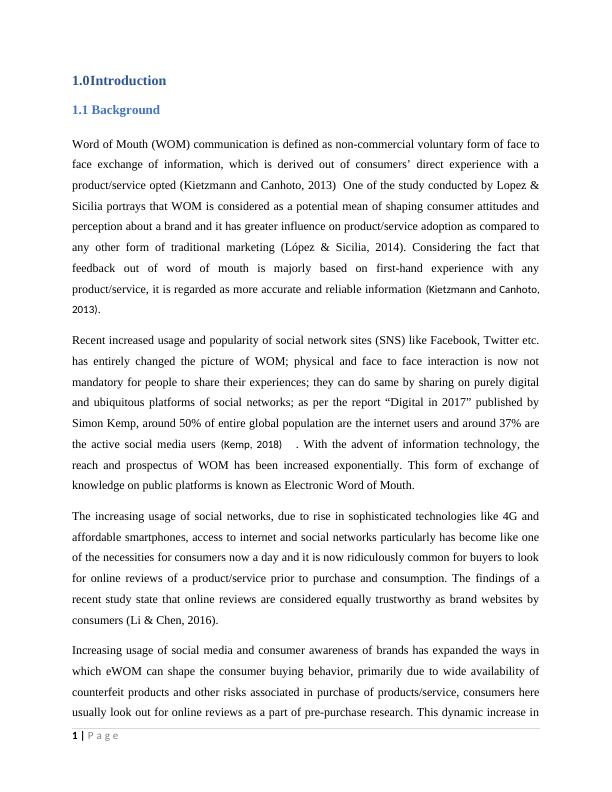
consumer’s choice for online feedback and reviews has alerted brands to focus on enhancing
their digital presence. There are numerous social media groups and communities that provide a
centralized digital space for specifically sharing and discussing relevant experiences by
customers; that’s why today eWOM has become a stable element for online marketing mix for
several brands and companies.
McKinsey and Company published a report about eWOM and it states that the scope of eWOM
in developing markets is relatively higher than traditional advertising (Bughin, 2010. And the
opinion acquired by eWOM plays a pivotal role throughout three stages of consumer decision
making process (i.e. Initial consideration set, Active evaluation and Moment of purchase).
(Bughin, Doogan, & Ve, 2010). Saudi Arabia being one of the developing nations, presents an
attractive scenario for brand managers to take advantage of this emerging trend of eWOM.
The use of word of mouth is also one of the main reasons that helps in making the decisions by
the consumers regarding their purchasing behavior. It has a greater influence on purchasing the
products that are expensive in nature, as most of the consumers try to conduct researches and
take more opinions regarding whether the product will suit them or not. The revolution in the
digital world has resulted in the word of mouth to not limit themselves to a one-on-one
communication pattern but it can help in reaching more number of people at the same time. The
level of information that is available now regarding the products in the modern world also help in
reflecting on the decisions that are taken by them with respect to the purchase of the goods. The
decision to purchase the products by the consumers is made through the recommendations and
the awareness that gets spread by the other consumers. The positive and negative sides of the
products are analyzed so that it can help the consumers in getting the maximum benefit.
According to the latest McKinsey report, there are three types of word of mouth marketing that is
experiential, consequential and intentional. The experiential marketing is the most powerful one
and helps the consumers in gaining a direct experience regarding the products and services and
its expectations as well. Consequential on the other hand takes place when the consumers are
depicted the marketing campaigns that are traditional in nature. This takes place when the
advertisements have a direct effect on the consumers and the campaign that is taken up can help
in influencing the behavior of the consumers. Intentional is where the companies take the help of
2 | P a g e
their digital presence. There are numerous social media groups and communities that provide a
centralized digital space for specifically sharing and discussing relevant experiences by
customers; that’s why today eWOM has become a stable element for online marketing mix for
several brands and companies.
McKinsey and Company published a report about eWOM and it states that the scope of eWOM
in developing markets is relatively higher than traditional advertising (Bughin, 2010. And the
opinion acquired by eWOM plays a pivotal role throughout three stages of consumer decision
making process (i.e. Initial consideration set, Active evaluation and Moment of purchase).
(Bughin, Doogan, & Ve, 2010). Saudi Arabia being one of the developing nations, presents an
attractive scenario for brand managers to take advantage of this emerging trend of eWOM.
The use of word of mouth is also one of the main reasons that helps in making the decisions by
the consumers regarding their purchasing behavior. It has a greater influence on purchasing the
products that are expensive in nature, as most of the consumers try to conduct researches and
take more opinions regarding whether the product will suit them or not. The revolution in the
digital world has resulted in the word of mouth to not limit themselves to a one-on-one
communication pattern but it can help in reaching more number of people at the same time. The
level of information that is available now regarding the products in the modern world also help in
reflecting on the decisions that are taken by them with respect to the purchase of the goods. The
decision to purchase the products by the consumers is made through the recommendations and
the awareness that gets spread by the other consumers. The positive and negative sides of the
products are analyzed so that it can help the consumers in getting the maximum benefit.
According to the latest McKinsey report, there are three types of word of mouth marketing that is
experiential, consequential and intentional. The experiential marketing is the most powerful one
and helps the consumers in gaining a direct experience regarding the products and services and
its expectations as well. Consequential on the other hand takes place when the consumers are
depicted the marketing campaigns that are traditional in nature. This takes place when the
advertisements have a direct effect on the consumers and the campaign that is taken up can help
in influencing the behavior of the consumers. Intentional is where the companies take the help of
2 | P a g e
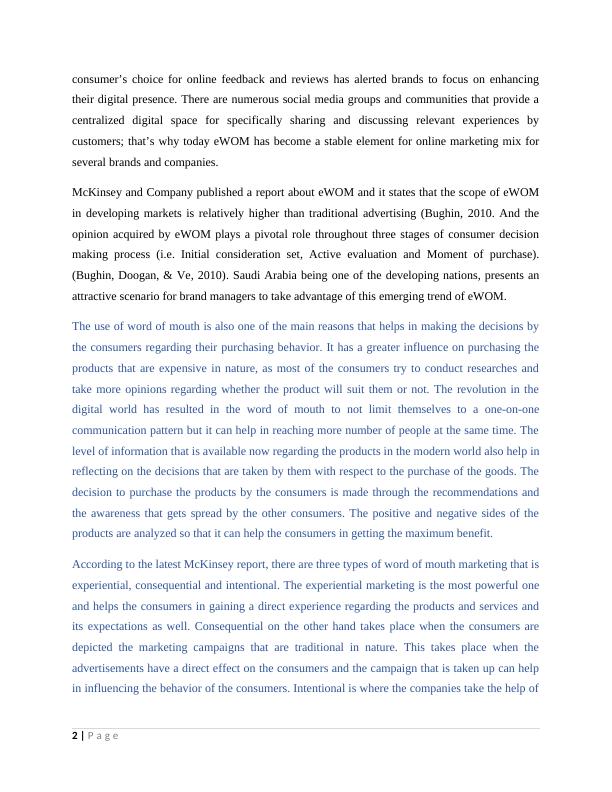
endorsing the brands through the celebrities so that it can create a positive image among the
consumers after the product gets launched.
Considering the scenario in Saudi Arabia, where out of approximate population of 32.28 million
(Central Intelligence Agency (CIA), 2014), around 65% of people are internet users, which is
about 20 million people and out of that, percentage of population present on Social media is
around 53% (Migael, 2016). The social media statistics of Saudi Arabia presents an attractive
scenario for brands to leverage on this competitive advantage. Around 60% of internet users in
country interact with brands online and 53% out of total population on social media is present on
Facebook, the number has been growing significantly every quarter and every 1 out of 5
Facebook users in country makes decisions that are influenced by Facebook. (Kemp, 2013)
The major problem in KSA is that the use of word of mouth marketing is not being delivered to
the right target customers. The McKinsey report had stated that 70 percent of the companies in
KSA are failing to attract customers due to the lack of technology. The use of proper information
system that will help in educating the customers regarding the products and services that the
company deals with will help in increasing the sale for the organization as well (Li & Chen,
2016). This is due to the fact that most of the companies are failing to attract the right customers
towards the products or the services. The use of the right marketing mix needs to be adopted by
the companies so that they can target the right audience through whom the products can be
marketed through word of mouth. This study will focus mainly on the right methods that needs
to be taken up so that the word of mouth marketing can be effective in nature. This will also
allow the companies in increasing their opportunity to have a better rate of return by selling the
right products to the right customers.
There are numerous industries in country that can take advantage of eWOM by adopting this
new trend. Food industry is one of the fastest growing industry in Saudi Arabia. The Food &
beverage industry in Saudi Arabia remains one of the most attractive in the region: KSA’s food
industry remains one of the most attractive in the region, with strong sales growth expectation
over our forecast period. On an average, KSA imports ~80% of its food requirement where food
accounts for ~15% of its total imports. Based on the governments’ initiatives (NPL) to overcome
obstacles on foreign investment, Saudi Arabia’s food processing sector is expected to attract
strong investment, particularly in the key segments, which are contributing to the growth in local
3 | P a g e
consumers after the product gets launched.
Considering the scenario in Saudi Arabia, where out of approximate population of 32.28 million
(Central Intelligence Agency (CIA), 2014), around 65% of people are internet users, which is
about 20 million people and out of that, percentage of population present on Social media is
around 53% (Migael, 2016). The social media statistics of Saudi Arabia presents an attractive
scenario for brands to leverage on this competitive advantage. Around 60% of internet users in
country interact with brands online and 53% out of total population on social media is present on
Facebook, the number has been growing significantly every quarter and every 1 out of 5
Facebook users in country makes decisions that are influenced by Facebook. (Kemp, 2013)
The major problem in KSA is that the use of word of mouth marketing is not being delivered to
the right target customers. The McKinsey report had stated that 70 percent of the companies in
KSA are failing to attract customers due to the lack of technology. The use of proper information
system that will help in educating the customers regarding the products and services that the
company deals with will help in increasing the sale for the organization as well (Li & Chen,
2016). This is due to the fact that most of the companies are failing to attract the right customers
towards the products or the services. The use of the right marketing mix needs to be adopted by
the companies so that they can target the right audience through whom the products can be
marketed through word of mouth. This study will focus mainly on the right methods that needs
to be taken up so that the word of mouth marketing can be effective in nature. This will also
allow the companies in increasing their opportunity to have a better rate of return by selling the
right products to the right customers.
There are numerous industries in country that can take advantage of eWOM by adopting this
new trend. Food industry is one of the fastest growing industry in Saudi Arabia. The Food &
beverage industry in Saudi Arabia remains one of the most attractive in the region: KSA’s food
industry remains one of the most attractive in the region, with strong sales growth expectation
over our forecast period. On an average, KSA imports ~80% of its food requirement where food
accounts for ~15% of its total imports. Based on the governments’ initiatives (NPL) to overcome
obstacles on foreign investment, Saudi Arabia’s food processing sector is expected to attract
strong investment, particularly in the key segments, which are contributing to the growth in local
3 | P a g e
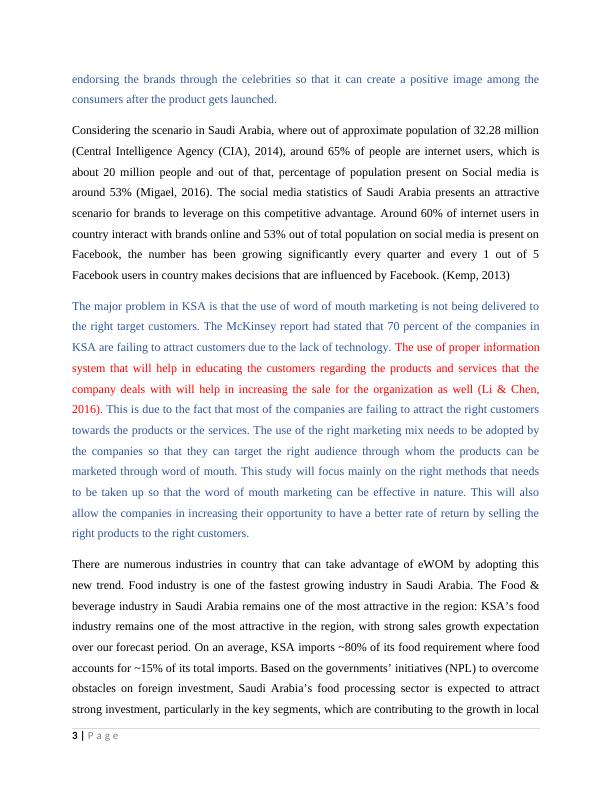
food consumption. The expansion of the big organized food retailing and producer such as
AlMarai and Savola will continue to strengthen internal trade systems and local food production,
which is expected to contribute to lower cost, that can be passed on to consumers partially
offsetting impact of value added tax (VAT) (Saudi Food & Beverage Industry Report 2017).
There exists significant influence of eWOM on Food industry and this can be justified by
observing the increase in number of such online communities that are dedicated to discussion
about food; although this impact has not been studied so far but the influence can’t be denied.
1.2 Research Statement
“To determine the factors that result in adoption of information on social network and impact of
such adoption on brand image and purchase intentions of recipient of information.
1.3 Research Objective
To find out determinants that result in making an online information useful to be adopted
To determine the impact of electronic word of mouth on brand image of any
product/service
To determine the impact does eWOM has on Purchase Intention of the consumers
1.4 Research Hypothesis:
Since this study follows two different research frameworks for research thus the entire study has
been divided into two stages. Each stage consists of hypothesis based on variables Below given
are hypotheses of study and research frameworks are discussed later in report.
Stage 1:
H0: Online Review on Social Media don’t impact the Brand Image of the Brand.
1.5 Purpose of the Study
As already established in this report that electronic word of mouth holds significant influence on
fast growing food sector and the number of such dedicated communities about food/eateries
discussion has been growing time to time; brands are starting to magnify their digital and social
media presence. But since there hasn’t been any study with respect to the topic, this research is
4 | P a g e
AlMarai and Savola will continue to strengthen internal trade systems and local food production,
which is expected to contribute to lower cost, that can be passed on to consumers partially
offsetting impact of value added tax (VAT) (Saudi Food & Beverage Industry Report 2017).
There exists significant influence of eWOM on Food industry and this can be justified by
observing the increase in number of such online communities that are dedicated to discussion
about food; although this impact has not been studied so far but the influence can’t be denied.
1.2 Research Statement
“To determine the factors that result in adoption of information on social network and impact of
such adoption on brand image and purchase intentions of recipient of information.
1.3 Research Objective
To find out determinants that result in making an online information useful to be adopted
To determine the impact of electronic word of mouth on brand image of any
product/service
To determine the impact does eWOM has on Purchase Intention of the consumers
1.4 Research Hypothesis:
Since this study follows two different research frameworks for research thus the entire study has
been divided into two stages. Each stage consists of hypothesis based on variables Below given
are hypotheses of study and research frameworks are discussed later in report.
Stage 1:
H0: Online Review on Social Media don’t impact the Brand Image of the Brand.
1.5 Purpose of the Study
As already established in this report that electronic word of mouth holds significant influence on
fast growing food sector and the number of such dedicated communities about food/eateries
discussion has been growing time to time; brands are starting to magnify their digital and social
media presence. But since there hasn’t been any study with respect to the topic, this research is
4 | P a g e
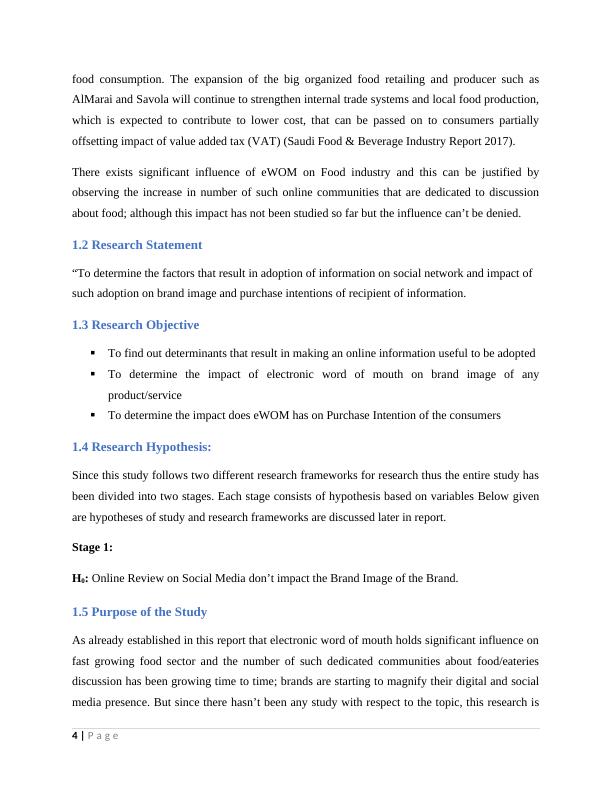
being conducted to explore the entire phenomena and process of Electronic Word of Mouth in
Food industry.
The purpose of this study is to find out the extent to which consumers adapt and accept the
information available online and the determinants that result in such adaption. It also concludes
that how eWOM through social media sites among consumers influence the brand image. It is
aimed at conducting a quantitative investigation on overall phenomenon of eWOM.
In order to achieve specified objective, this study has been particularly focused on Electronic
Word of Mouth on Eateries (Restaurants, Hotels, Dhabas, Cafes and Take-outs) and for
accomplishing that purpose this research is based on eWOM0 generated on a subject-dedicated
social media platform, where food lovers usually discuss and rate the various features like
hygiene, taste, price, ambience etc. on the basis of their personal experience.
5 | P a g e
Food industry.
The purpose of this study is to find out the extent to which consumers adapt and accept the
information available online and the determinants that result in such adaption. It also concludes
that how eWOM through social media sites among consumers influence the brand image. It is
aimed at conducting a quantitative investigation on overall phenomenon of eWOM.
In order to achieve specified objective, this study has been particularly focused on Electronic
Word of Mouth on Eateries (Restaurants, Hotels, Dhabas, Cafes and Take-outs) and for
accomplishing that purpose this research is based on eWOM0 generated on a subject-dedicated
social media platform, where food lovers usually discuss and rate the various features like
hygiene, taste, price, ambience etc. on the basis of their personal experience.
5 | P a g e
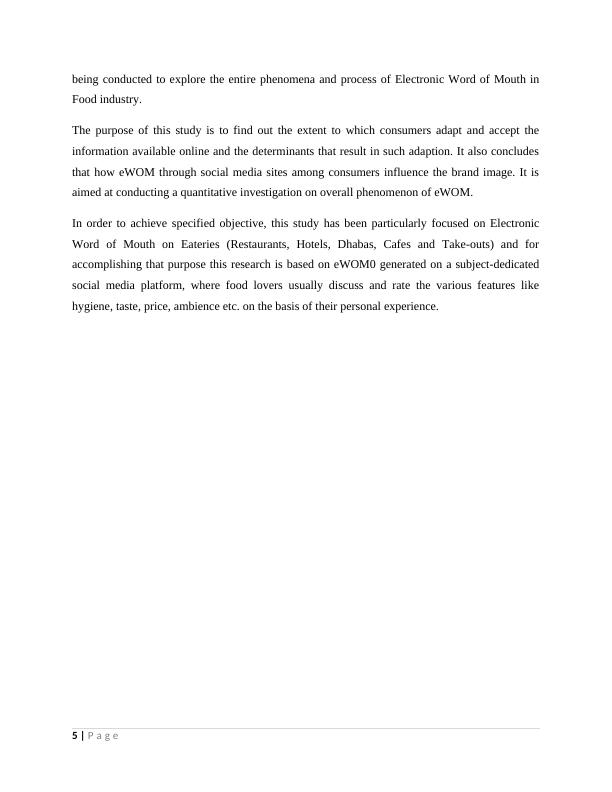
1.6 Literature Review
The marketing that is done through word-of-mouth helps in generating the interest of the
consumers towards the products or services that are being offered by the company. It is through
the dialogues of the consumers that the product of the companies get marketed in a better manner
and increase its level of popularity as well in the market (Lee, Kim & Chan, 2011). It can be
defined as the process where the consumers refer their friends and relatives to the companies
whose products have provided them in increasing their level of satisfaction. It also refers to the
factor of pricing for the products, as the increase in the level of satisfaction may have a positive
impact on the prices that are set by the companies. The low prices of the products that may
increase the satisfaction level will be referred by the consumers more frequently to their friends
and relatives (Trusov, Bucklin & Bodapati, 2010).
Advent of communication technologies and increase in usage of internet globally has
transformed the arena of marketing and brand communication; it has also entirely changed the
metamorphosis of information sharing mechanism. Due to increasing ease of internet access
consumers are now no longer imprisoned by limited geographical accessibility or physical space,
internet has facilitated consumers with ubiquity and global reach. All of this dramatic change in
horizons of mainstream and electronic media has originated over the past decade (Alves,
Fernandes & Raposo, 2016)
This electronic revolution has provided business one more competitive edge to leverage upon,
because digital media provides brands with a centralized e-space to interact with their target
customers market their respective offering and create awareness at a very minimal cost. Such
interaction has been deemed as substantially potential contributor towards financial health of
brands and businesses.
Prior to this technological development, brands relied more on traditional form of
communication mediums for marketing and branding activities, besides Word of mouth
6 | P a g e
The marketing that is done through word-of-mouth helps in generating the interest of the
consumers towards the products or services that are being offered by the company. It is through
the dialogues of the consumers that the product of the companies get marketed in a better manner
and increase its level of popularity as well in the market (Lee, Kim & Chan, 2011). It can be
defined as the process where the consumers refer their friends and relatives to the companies
whose products have provided them in increasing their level of satisfaction. It also refers to the
factor of pricing for the products, as the increase in the level of satisfaction may have a positive
impact on the prices that are set by the companies. The low prices of the products that may
increase the satisfaction level will be referred by the consumers more frequently to their friends
and relatives (Trusov, Bucklin & Bodapati, 2010).
Advent of communication technologies and increase in usage of internet globally has
transformed the arena of marketing and brand communication; it has also entirely changed the
metamorphosis of information sharing mechanism. Due to increasing ease of internet access
consumers are now no longer imprisoned by limited geographical accessibility or physical space,
internet has facilitated consumers with ubiquity and global reach. All of this dramatic change in
horizons of mainstream and electronic media has originated over the past decade (Alves,
Fernandes & Raposo, 2016)
This electronic revolution has provided business one more competitive edge to leverage upon,
because digital media provides brands with a centralized e-space to interact with their target
customers market their respective offering and create awareness at a very minimal cost. Such
interaction has been deemed as substantially potential contributor towards financial health of
brands and businesses.
Prior to this technological development, brands relied more on traditional form of
communication mediums for marketing and branding activities, besides Word of mouth
6 | P a g e

communication was regarded as more potential driver behind consumer’s attitudes and purchase
intentions towards any brand and this stance has been validated by numerous studies and
researches.
With the progress of internet network which gives choices of information regarding a product
allowing a form of word-of-mouth communication that not only become a person-to-person form
of communication about a product or service (Lee, Kim, & Chan, 2011), but also capable to turn
into many forms of word-of-mouth communication that spread globally. This form of
communication is generally called Electronic Word of Mouth. The purpose of this literature
review is to focus on the e-WOM, its impact and the potential benefits it has for businesses. This
review will contain information gathered and analyzed from different peer reviewed articles and
studies to support the credibility of this paper.
1.6.1 General Marketing Communication
Studies has already established a positive influence of marketing communication on outcomes of
marketing like brand awareness, sales etc. As a matter of fact, marketing communications are
considered as the key drivers of brand equity, brand loyalty and brand awareness. Marketing
communication has been classified in several types and classes based on application and scope
by marketing gurus. This literature review focuses one of the major component of marketing
communication i.e. Word of Mouth.
1.7 Traditional and Electronic Word of Mouth
The terms of traditional word of mouth and electronic word of mouth are often used together,
when the scope and impact of consumer reviews on their attitudes and intentions is questioned.
Traditional Word of mouth is more generic and primary form of word of mouth terminology ever
coined, it is offline form of exchange of product/service related information between consumers,
this information is usually generated by consumers based on past experiences.
It is widely viewed, tested and accepted fact that word of mouth communication plays a very
grave role in influencing, shaping and development of consumer’s attitudes and behaviors; This
form of communication practiced holds more driving force towards product adoption than other
traditional forms of marketing communication. (Trusov, Bucklin, & Bodapati, 2010).
7 | P a g e
intentions towards any brand and this stance has been validated by numerous studies and
researches.
With the progress of internet network which gives choices of information regarding a product
allowing a form of word-of-mouth communication that not only become a person-to-person form
of communication about a product or service (Lee, Kim, & Chan, 2011), but also capable to turn
into many forms of word-of-mouth communication that spread globally. This form of
communication is generally called Electronic Word of Mouth. The purpose of this literature
review is to focus on the e-WOM, its impact and the potential benefits it has for businesses. This
review will contain information gathered and analyzed from different peer reviewed articles and
studies to support the credibility of this paper.
1.6.1 General Marketing Communication
Studies has already established a positive influence of marketing communication on outcomes of
marketing like brand awareness, sales etc. As a matter of fact, marketing communications are
considered as the key drivers of brand equity, brand loyalty and brand awareness. Marketing
communication has been classified in several types and classes based on application and scope
by marketing gurus. This literature review focuses one of the major component of marketing
communication i.e. Word of Mouth.
1.7 Traditional and Electronic Word of Mouth
The terms of traditional word of mouth and electronic word of mouth are often used together,
when the scope and impact of consumer reviews on their attitudes and intentions is questioned.
Traditional Word of mouth is more generic and primary form of word of mouth terminology ever
coined, it is offline form of exchange of product/service related information between consumers,
this information is usually generated by consumers based on past experiences.
It is widely viewed, tested and accepted fact that word of mouth communication plays a very
grave role in influencing, shaping and development of consumer’s attitudes and behaviors; This
form of communication practiced holds more driving force towards product adoption than other
traditional forms of marketing communication. (Trusov, Bucklin, & Bodapati, 2010).
7 | P a g e
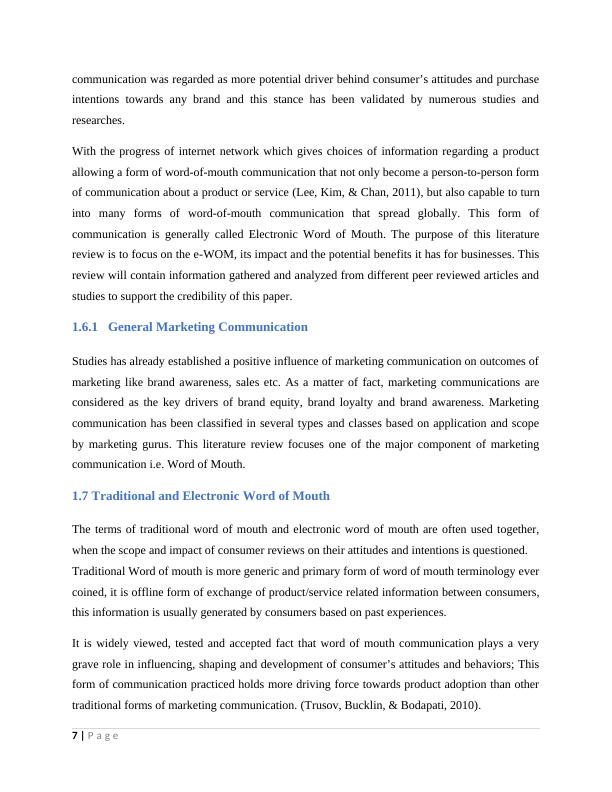
Besides researches have also established the dominance of word of mouth communication over
other traditional sources such as editorial, advertisements etc., in terms of overall influence.
(Bickart & Schindler, 2011), the reason is merely because of it is regarded as more credible and
first-hand experience of any product/service. And this credibility also adds in the factor of
persuasiveness in the information, which ultimately impacts the decision-making process while
purchase of any product/service. A survey in the recent past found that majority of the consumers
or opinion seekers regard online opinions, reviews, comments to be equally trustworthy and
credible as that of the websites of particular brand or service (Watfa, Najafi & Bakkar, 2013)
WOM has much more influence on the purchase intentions of the consumers in the professional
and services arena than that of other sources. One reason might be as people consider their
personal relationships more trustworthy and are more inclined to follow what people in their
relationship circle say (Arena, Rondan, & Ram\'\irez, 2013).
Technological advent and rise of internet communication has brought a less personal but more
widely accessible and geographically independent and ubiquitous form of word of mouth
communication which is known as electronic word of mouth or online word of mouth. (Mardon
& Belk, 2018)
(Bickart & Schindler, 2011) Has defined eWOM as “any of the affirmative or undesirable statement
left by the real, potential or previous customer about a brand/product or the company which is
accessible to the masses or institutions through internet sources”
This form of word of mouth, which is electronic by nature, is considered as more influential and
effective than traditional word of mouth because it is widely accessible and possesses higher
reach than the latter one. The traditional word of mouth is the predecessor to electronic word of
mouth which is the one to one verbal conversation between the encoder and the decoder (Alves,
Fernandes & Raposo, 2016)
The traditional pattern of WOM is generally practiced among the individuals who are closely
connected and have trust among each other (Guptaa & Harris, 2010) whereas eWOM is practiced
among the individuals who are strangers around the world besides their family and friends circle
and co-workers. Though there has been lot of research conducted on eWOM but still this area
requires more research to be conducted (Zhanga , Craciuna , & Shinb, 2010).
8 | P a g e
other traditional sources such as editorial, advertisements etc., in terms of overall influence.
(Bickart & Schindler, 2011), the reason is merely because of it is regarded as more credible and
first-hand experience of any product/service. And this credibility also adds in the factor of
persuasiveness in the information, which ultimately impacts the decision-making process while
purchase of any product/service. A survey in the recent past found that majority of the consumers
or opinion seekers regard online opinions, reviews, comments to be equally trustworthy and
credible as that of the websites of particular brand or service (Watfa, Najafi & Bakkar, 2013)
WOM has much more influence on the purchase intentions of the consumers in the professional
and services arena than that of other sources. One reason might be as people consider their
personal relationships more trustworthy and are more inclined to follow what people in their
relationship circle say (Arena, Rondan, & Ram\'\irez, 2013).
Technological advent and rise of internet communication has brought a less personal but more
widely accessible and geographically independent and ubiquitous form of word of mouth
communication which is known as electronic word of mouth or online word of mouth. (Mardon
& Belk, 2018)
(Bickart & Schindler, 2011) Has defined eWOM as “any of the affirmative or undesirable statement
left by the real, potential or previous customer about a brand/product or the company which is
accessible to the masses or institutions through internet sources”
This form of word of mouth, which is electronic by nature, is considered as more influential and
effective than traditional word of mouth because it is widely accessible and possesses higher
reach than the latter one. The traditional word of mouth is the predecessor to electronic word of
mouth which is the one to one verbal conversation between the encoder and the decoder (Alves,
Fernandes & Raposo, 2016)
The traditional pattern of WOM is generally practiced among the individuals who are closely
connected and have trust among each other (Guptaa & Harris, 2010) whereas eWOM is practiced
among the individuals who are strangers around the world besides their family and friends circle
and co-workers. Though there has been lot of research conducted on eWOM but still this area
requires more research to be conducted (Zhanga , Craciuna , & Shinb, 2010).
8 | P a g e
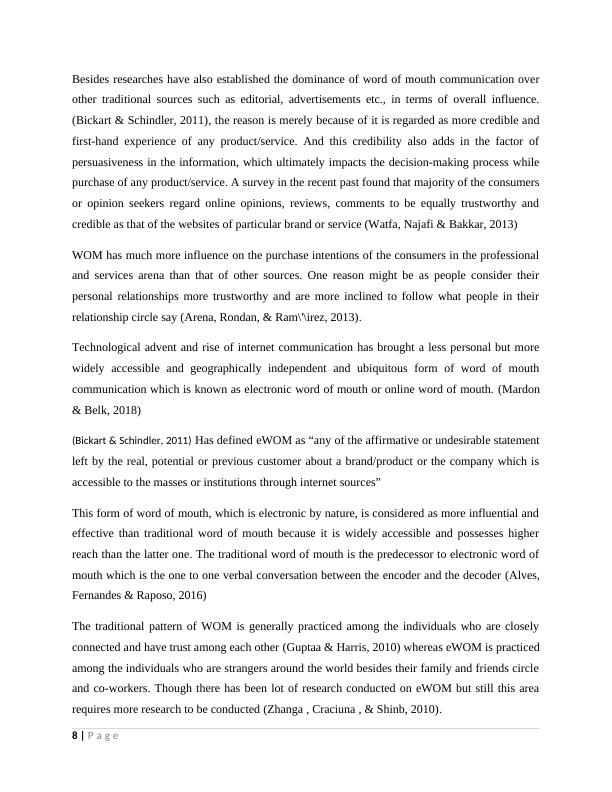
End of preview
Want to access all the pages? Upload your documents or become a member.
Related Documents
The Impact of Electronic Word-of-Mouth on Scuba Diving Purchasing Decisions in Hong Konglg...
|28
|5574
|181
Impact of User Generated Contents from Social Media on Consumer Buying Behaviorlg...
|5
|816
|451
Understanding Social Marketing Assignmentlg...
|7
|1543
|29
Impact of Advertising on Acquiring New Customers for London Based Driving Schoollg...
|16
|2008
|404
Impact of eWOM on the video game: Effect on consumer purchasing decisionlg...
|40
|11452
|419
Word of mouth is a reflection of customerslg...
|21
|701
|110
